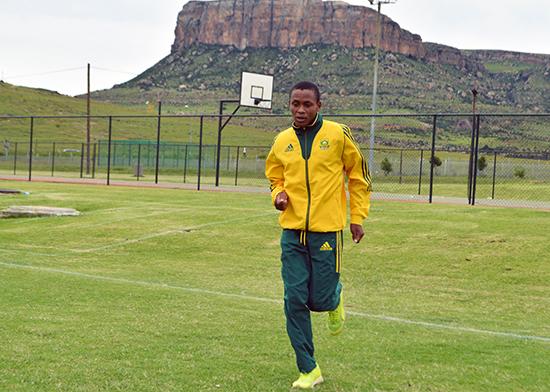Latest News Archive
Please select Category, Year, and then Month to display items
22 February 2018
Photo Thabo Kessah
 Pakiso Mthembu will be representing South Africa in Mauritius and Algeria.
Pakiso Mthembu will be representing South Africa in Mauritius and Algeria.
This year, the University of the Free State’s Qwaqwa Campus will unleash a running sensation that is equally comfortable on track, cross-country, and road running and is on a mission to conquer the world. His name is Pakiso Mthembu from Tweeling in the Eastern Free State. Pakiso has recently qualified for the Junior Men’s Southern Region cross-country championships that will be held in Mauritius on 24 February and in Algeria on 17 March 2018.
“I am glad that I managed to run my personal best time of 24:02 during the qualification trials held in Bloemfontein in January, which set me on the road to Mauritius and Algeria,” said Pakiso, a BEd FET first-year student.
His personal best in the 10 km road-running category and in the 5 000 m track are 30:55 and 14:29, respectively.
Praise for Soke
“It is only through dedication, hard work, and listening to my coach that I can achieve my dreams of representing South Africa at the International Association of Athletics Federations World Junior Championships (IAAF) to be held in Finland in July, and at the 2020 Tokyo Olympics. I have one of the best coaches in this part of the world and it gives me great pleasure to work with him, having grown up admiring him during his days,” he says in reference to Boy Soke, who identified his talent and recruited him to the Qwaqwa Campus.
Pakiso has already represented South Africa in Uganda.
Mathematical methods used to detect and classify breast cancer masses
2016-08-10
 Examples of Acho’s breast mass
Examples of Acho’s breast mass
segmentation identification
Breast cancer is the leading cause of female mortality in developing countries. According to the World Health Organization (WHO), the low survival rates in developing countries are mainly due to the lack of early detection and adequate diagnosis programs.
Seeing the picture more clearly
Susan Acho from the University of the Free State’s Department of Medical Physics, breast cancer research focuses on using mathematical methods to delineate and classify breast masses. Advancements in medical research have led to remarkable progress in breast cancer detection, however, according to Acho, the methods of diagnosis currently available commercially, lack a detailed finesse in accurately identifying the boundaries of breast mass lesions.
Inspiration drawn from pioneer
Drawing inspiration from the Mammography Computer Aided Diagnosis Development and Implementation (CAADI) project, which was the brainchild Prof William Rae, Head of the department of Medical Physics, Acho’s MMedSc thesis titled ‘Segmentation and Quantitative Characterisation of Breast Masses Imaged using Digital Mammography’ investigates classical segmentation algorithms, texture features and classification of breast masses in mammography. It is a rare research topic in South Africa.
Characterisation of breast masses, involves delineating and analysing the breast mass region on a mammogram in order to determine its shape, margin and texture composition. Computer-aided diagnosis (CAD) program detects the outline of the mass lesion, and uses this information together with its texture features to determine the clinical traits of the mass. CAD programs mark suspicious areas for second look or areas on a mammogram that the radiologist might have overlooked. It can act as an independent double reader of a mammogram in institutions where there is a shortage of trained mammogram readers.
Light at the end of the tunnel
Breast cancer is one of the most common malignancies among females in South Africa. “The challenge is being able to apply these mathematical methods in the medical field to help find solutions to specific medical problems, and that’s what I hope my research will do,” she says.
By using mathematics, physics and digital imaging to understand breast masses on mammograms, her research bridges the gap between these fields to provide algorithms which are applicable in medical image interpretation.